With short sets from small groups in unexpected spots, the festival creates a communal experience that’s pandemic safe.
By Bill Meyer
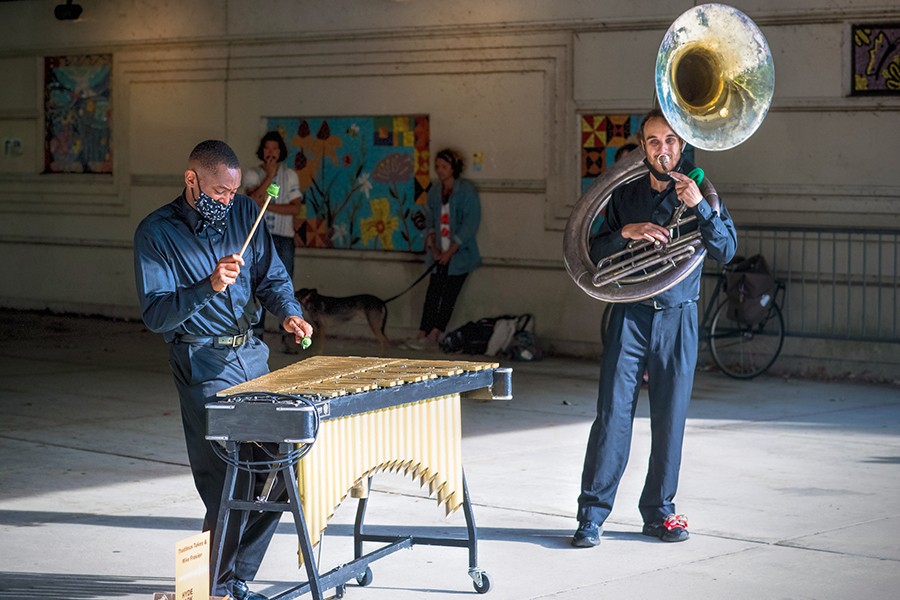
- Thaddeus Tukes and Mike Frasier at the mouth of the pedway under Lake Shore Drive
- Michael Jackson for Chicago Reader
When the Hyde Park Jazz Festival’s executive and artistic director, Kate Dumbleton, spoke to the Reader in August about the fest’s efforts to adapt to COVID-19, she sounded hopeful that some version of the event would take place during its traditional time slot on the last weekend of September. Given that Chicago’s Department of Cultural Affairs and Special Events had already replaced an entire season of live outdoor programming with prerecorded video broadcasts—and that no one knew if, when, and how hard a second wave of COVID infections would hit the city—that hope seemed wildly optimistic. But the virus held off, and the festival did hold events both its usual days.
Of course, none of those events was anything like last year’s festival, which featured big outdoor stages and a strip of merch booths on the Midway Plaisance, indoor shows at small venues, and a climactic concert by a large ensemble inside Rockefeller Chapel. On Saturday, six mostly masked bands livestreamed themselves playing to empty seats in the auditorium of the Logan Center for the Arts on the University of Chicago campus. And on Sunday, 18 small, brief concerts took place in parks, pedways, and sidewalks between 40th and 61st Streets.
It’s been more than six months since the start of lockdown, and streamed musical performances—the most widespread adaptation to the shuttering of venues—continue to vary wildly in professionalism, sound quality, and creativity of presentation. You might end up watching someone who’s forgotten to activate his phone’s auto-rotate function play guitar on his couch, or you could get a set with the production values of a prerecorded music video. But in any case, it’s not the same as seeing live music in person.
The Hyde Park Jazz Festival’s response to this unsatisfactory set of circumstances was to have bands perform live in an empty theater, with concert-level lighting and sound. Unlike many livestreams, the sets were not archived—you could only hear the music while it was being played. In that sense, they were a little more like real concerts.
In recent years the HPJF’s programming has struck a careful balance: on one hand, user-friendly music suited to an end-of-summer picnic with the neighbors, and on the other, new work that reflects jazz’s contemporary musical, social, and political advances. Cost and travel restrictions limited the 2020 festival to mainly local bookings, but it could still present a cross section of comforting and challenging fare.
On Saturday, the Alexis Lombre Quartet opened the day of livestreams with a set that fulfilled the young singer-keyboardist’s pledge to “keep the soul in music alive.” Her pretty singing and airy instrumental exchanges with second keyboardist Jahari Stampley made for pleasant background fare, but the platitudinous quality of her lyrics did little to reward closer listening.
Alto saxophonist Greg Ward and his band Rogue Parade put weights down on both sides of the scale, luring in listeners with the leader’s bright melodies and then spinning their heads with metrical and tempo shifts and a guitar-heavy sound that recalled vintage jazz-rock fusion. Charles Heath’s quartet underscored the drummer’s association with Ramsey Lewis with a Heath original whose groove echoes “The ‘In’ Crowd,” but they devoted most of their set to robust performances of mid-20th-century standards such as “A Night in Tunisia” and “Yesterdays.”
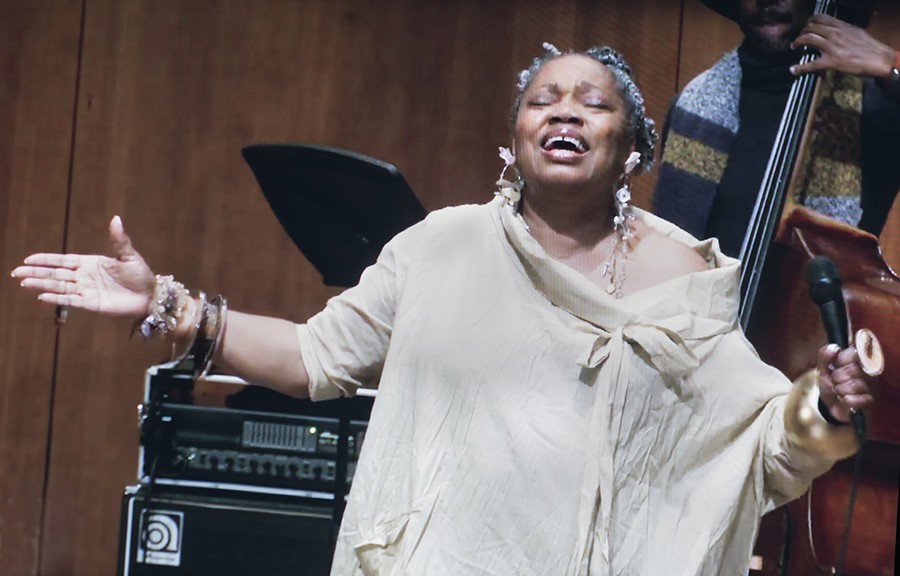
- Dee Alexander and her band the A-Team included a new song called “Protest” in their livestreamed set.
- Michael Jackson for Chicago Reader
Singer Dee Alexander and her four-piece, the A-Team, jolted attention back to the present moment with “Protest,” a newly written song addressing racist killings and the rage and grief they cause. But while the words were full of pain, the quartet’s mercurial improvisations embodied the think-on-your-feet flexibility that helps protesters survive violent police repression, and Alexander’s freewheeling vocalizing supplied plenty of transcendental thrills.
Trumpeter Marquis Hill has been based in New York since 2014, but he grew up on the south side, and his Circle in the Round quintet was designed to celebrate the local talents who filled out the lineup. After a sternly lyrical opening duet by Hill and drummer Dana Hall, members of the group started leaving the stage to sit out, then returning to play again—only bassist Junius Paul stayed throughout. Pianist Michael King and saxophonist Irvin Pierce each led a subset of musicians through one of their own tunes, but the stylistic discontinuities involved in going back and forth between brisk modern jazz and smooth balladry proved frustrating.
Saturday’s closing set, by the Silent Hour, was far more cohesive. The group comprises drummer Mike Reed, cellist Tomeka Reid, and vibraphonist Jason Adasiewicz (all members of Reed’s Loose Assembly), for this show joined by guests Russ Johnson on trumpet and Jakob Heinemann on bass. They delivered a series of tone poems illuminated by glowing trumpet-cello harmonies and rendered mildly psychedelic by Adasiewicz’s electronic effects.
After Saturday delivered a professionally mounted cross section of jazz to everyone’s favorite screens, Sunday gave people willing to leave the house a chance to enjoy something that’s been in scarce supply these past seven months—musicians playing in front of them. Granted, these musicians had to contend with (or feed upon) all the surprises that an uncontrolled outdoor environment presents, but the late September weather was perfect—in most years (2019 definitely excepted) it’s a reason unto itself for attending the festival. The organizers’ strategy—short sets from small ensembles in unexpected spaces—not only kept most crowds to a size that facilitated social distancing, but also encouraged people to spend time taking in spots they might not have known about and may well want to revisit.
The sites extended beyond the boundaries of Hyde Park-Kenwood to Oakland on the north and Washington Park to the west. Singer Maggie Brown, who’s played the festival every year since it was founded in 2007, brought the traditional Midway Plaisance vibe of folding chairs and friendly faces to the pavement outside the Green Line Performing Arts Center, a community theater space near the train tracks.
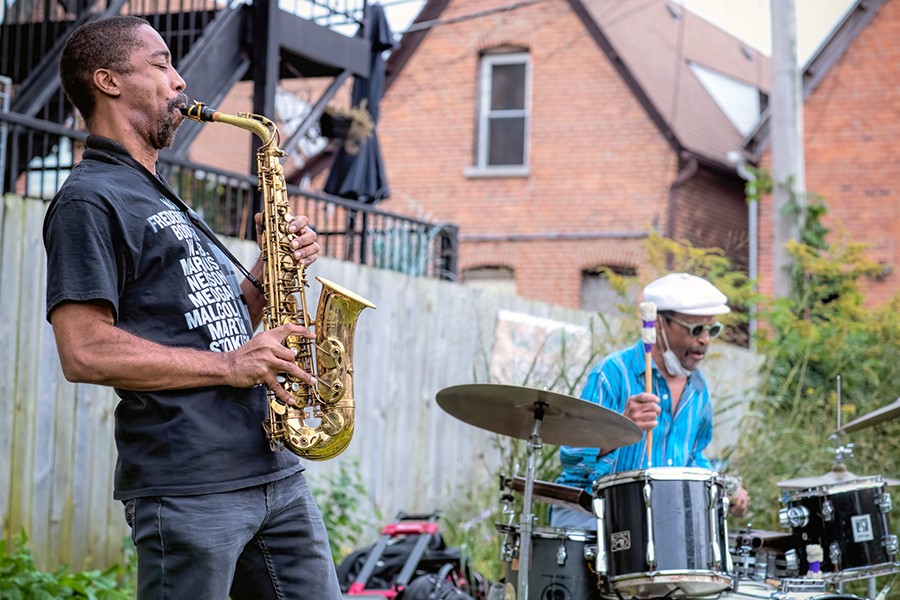
- Fred Jackson Jr. and Avreeayl Ra at the Oakland Museum of Contemporary Art
- Michael Jackson for Chicago Reader
Tenor saxophonist Fred Jackson Jr. and drummer Avreeayl Ra played blues-tinged, open-ended improvisations inspired by Wayne Shorter and Julius Hemphill in the Oakland Museum of Contemporary Art, which despite its name isn’t a building but rather an open-air green space where neighbors’ vegetable gardens sit beside wooden sculptures by the late Milton Mizenberg Jr. Another saxophone-drums duo, Nick Mazzarella and Quin Kirchner, played in Madison Park, a boulevard tucked away in a residential neighborhood. Surrounded by greenery and apartment buildings, their music felt like a winding, good-natured conversation between friends.
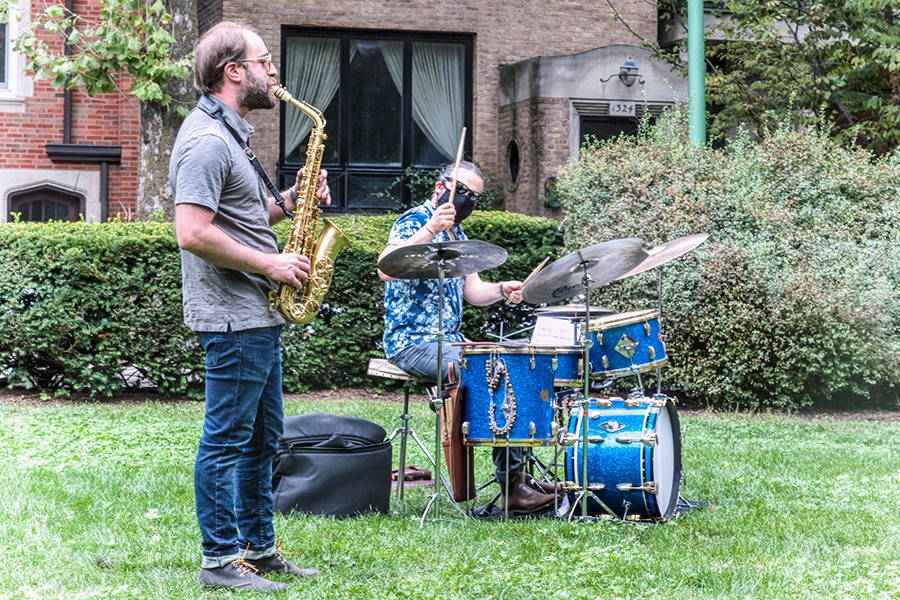
- Nick Mazzarella and Quin Kirchner in Madison Park
- Michael Jackson for Chicago Reader
The Russ Johnson Quartet played the festival’s southernmost show, on a stretch of pavement where the 61st Street Farmers Market sets up most Saturdays till the end of October. Johnson, a trumpeter who teaches at the University of Wisconsin-Parkside but plays Chicago as often as his academic schedule and the pandemic allow, explained to the audience that he’d had to find a new alto saxophonist on two days’ notice. Lenard Simpson not only took the gig—he invested the intricate unison lines of Johnson’s compositions with joyous effervescence that contrasted satisfyingly with the music’s muscular grooves.
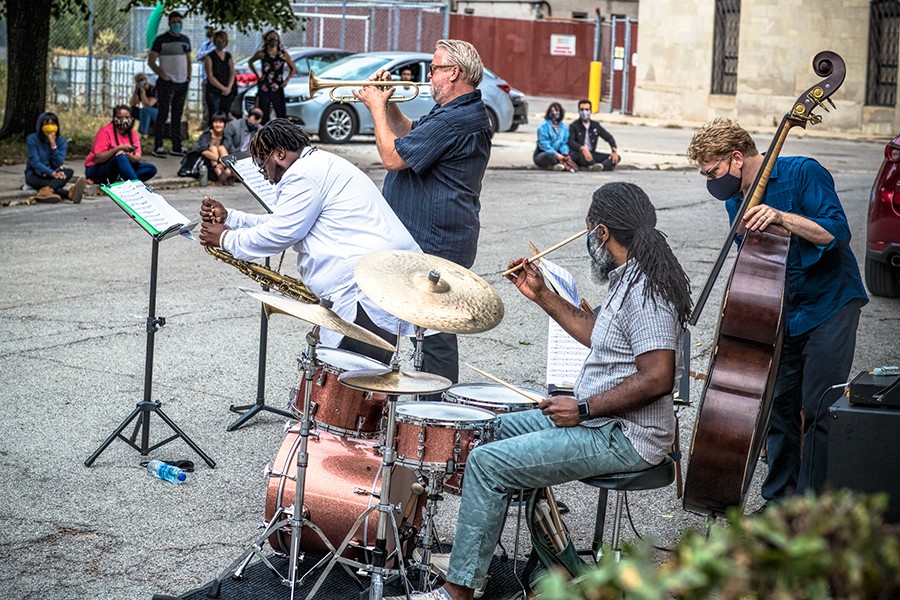
- The Russ Johnson Quartet set up near the usual site of the 61st Street Farmers Market.
- Michael Jackson for Chicago Reader
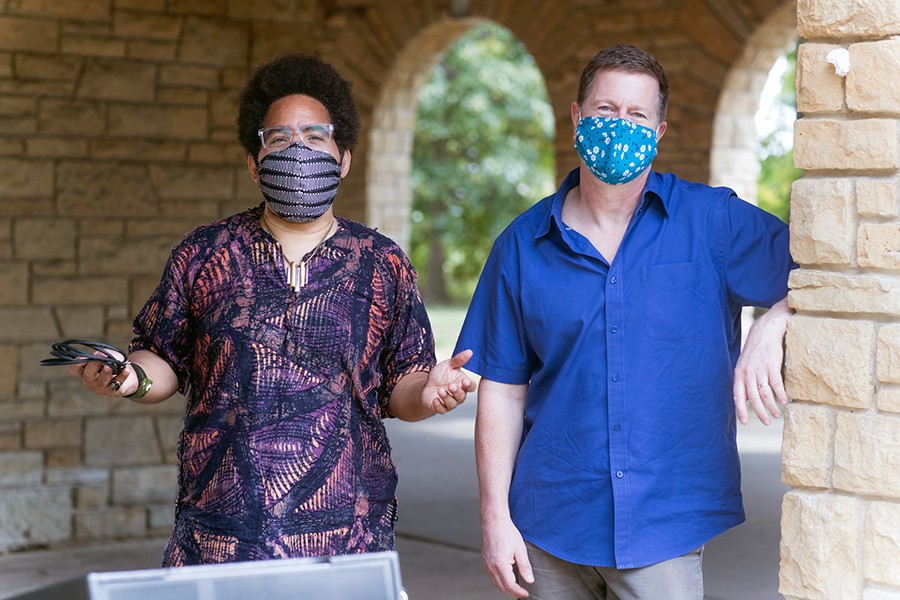
- Damon Locks and Ken Vandermark at the Iowa Building
- Michael Jackson for Chicago Reader
Early in the afternoon, reedist Ken Vandermark and Black Monument Ensemble bandleader Damon Locks set up within the arches of the Iowa Building, a pavilion built for the 1893 World’s Columbian Exposition. Old architecture framed spontaneous new sounds as their duo of tenor saxophone and electronics collaged elongated reed tones, synthetic bird sounds, and beats looped from old records.
Around the corner a couple hours later, vibraphonist Thaddeus Tukes and tubaist Mike Frasier set up in the mouth of a pedway tunnel to play a much more traditional set to a semicircle of listeners in folding chairs. While their instrumental lineup was unconventional, they played swinging standards such as “Autumn Leaves” and “What Is This Thing Called Love?” with genteel grace. But then, halfway through a winsome performance of Charlie Chaplin’s “Smile,” the sounds of brass and drums advanced upon the duo—a small marching band playing “When the Saints Go Marching In.” Tukes pushed his vibes out of their way, and Frasier joined in.
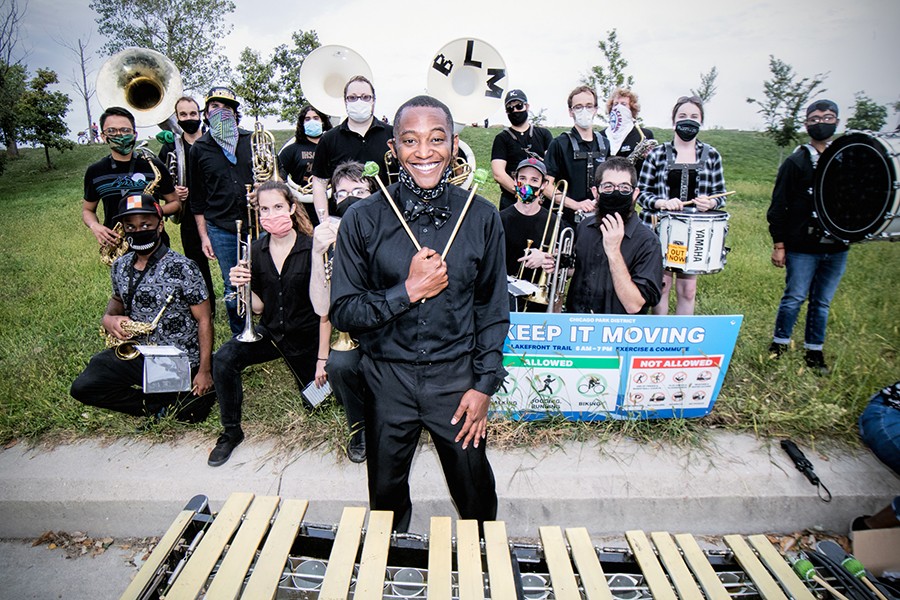
- Thaddeus Tukes and the Chicago Freedom Ensemble on the lakefront
- Michael Jackson for Chicago Reader
The crowd of young musicians led Tukes, Frasier, and the audience through the pedway under Lake Shore Drive and up a rise on the other side, setting up on a berm by the lakefront. Tukes introduced them as the recently formed Chicago Freedom Ensemble, then conducted the group in a set that included hymns associated with the civil rights movement, bebop tunes, and Marvin Gaye’s “What’s Going On.” They pulled off a creditable imitation of the New Orleans marching-band style—and though a lot of bad feelings have built up as we all endure an uncontrolled pandemic and our government’s increasingly contemptuous indifference to its own racist violence, that music was just the thing to lift everyone out of that hole, at least for a moment. v
We speak Chicago to Chicagoans, but we couldn’t do it without your help. Every dollar you give helps us continue to explore and report on the diverse happenings of our city. Our reporters scour Chicago in search of what’s new, what’s now, and what’s next. Stay connected to our city’s pulse by joining the Reader Revolution.
Are you in?
Not ready to commit? Send us what you can!